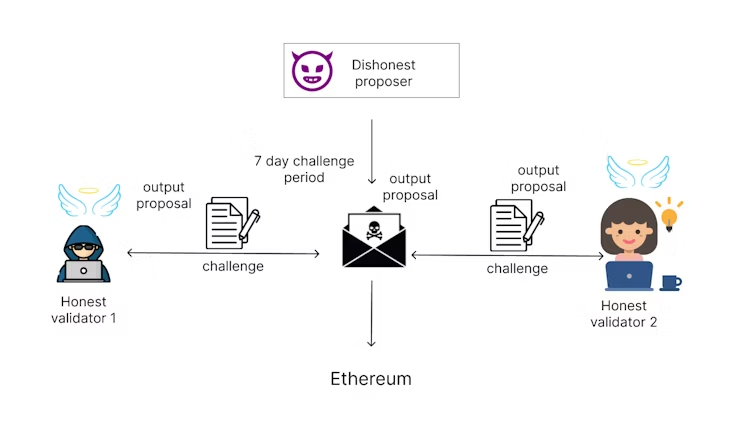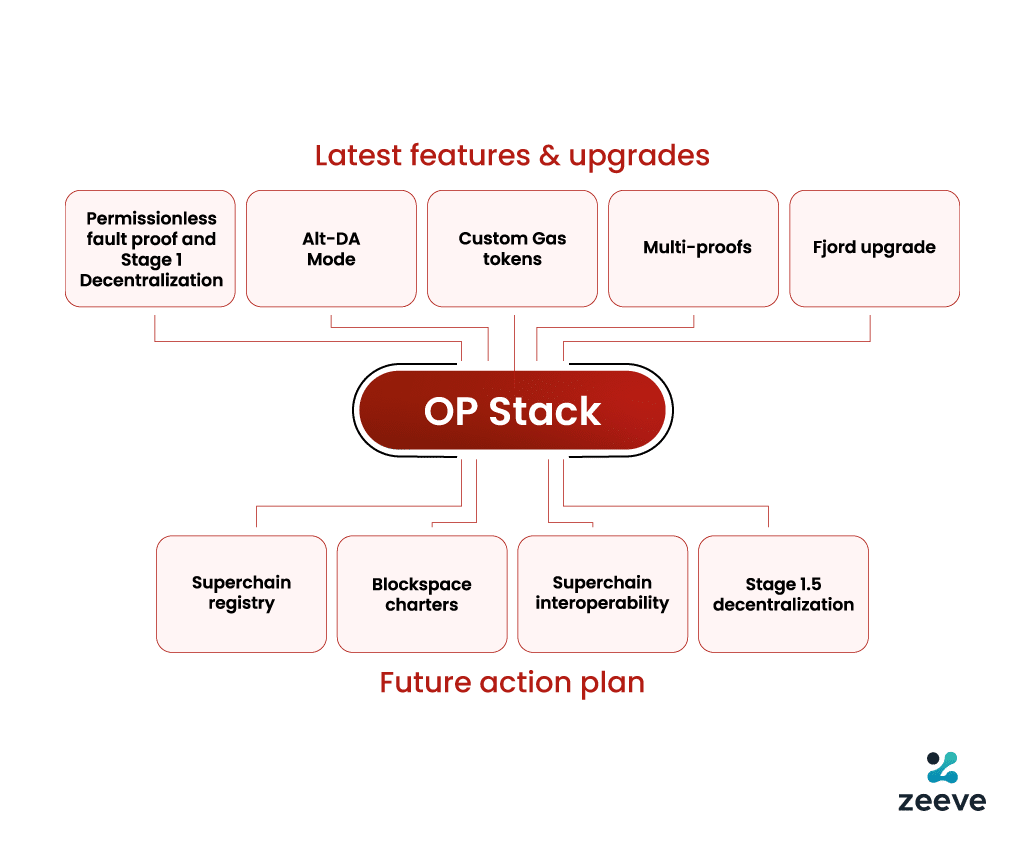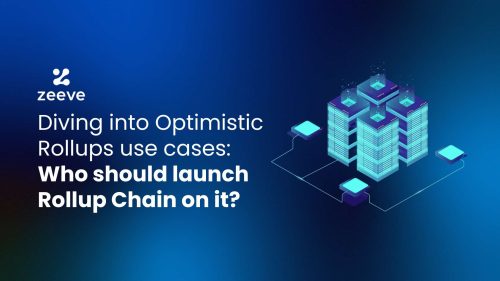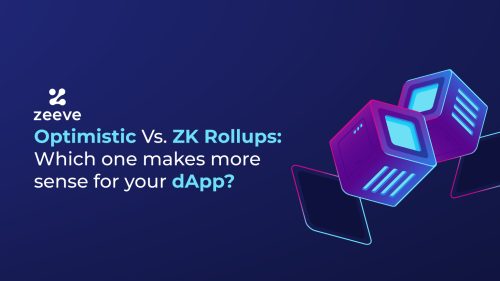What’s Hot on OP Stack? 2024’s Latest upgrades and What’s Coming?

OP Stack, the modular framework for building Optimistic rollup-powered modular chains, has recently rolled out a bunch of the hottest upgrades. From achieving Stage 1 decentralization with fault proof and stage to lowering transaction costs with Alt-DA and several exciting upgrades, OP Stack is gearing up perfectly to surpass its existing capabilities of powering more than 73.92% of all Layer2 throughput.
Hence, let’s explore the latest OP Stack upgrades and the future action plan in this post. This will give everyone a clear overview of what OP Stack is up to and where it aims to head eventually.

Latest OP Stack upgrades and features shipped in 2024
Below are the major upgrades that OP Stack announced most recently. These details are collected from OP Lab’s official announcements, docs, and social handles:
Permissionless fault proof and Stage 1 Decentralization
OP Labs, on June 24, announced the launch of governance-approved, permissionless fault proofs, which are live on Optimism mainnet, allowing OP Stack to reach Stage 1 decentralization and head towards the end game of Stage 2 decentralization. This OP Stack upgrade has been the biggest milestone for Superchain, and soon, all the other OP Stack chains like Base, Zora, and Metal can optimize themselves to support this functionality.
With a fault proof system, all the ERC-20 and ETH withdrawals can now be initiated without requiring any intervention of a 3rd party like sequencer, in a purely decentralized manner. Which means, users participating in the network can challenge any invalid withdrawal and sensor them once proven faulty. Despite the permissionless nature of fault proof systems, the Optimism security council always retains the power to interrupt and revert the entire system from permissionless to permissioned state. That happens in case of system failure or manual upgrade. Note that the Security council gets this power after it fulfills the 75% signing threshold criteria.
Other crucial components of the fault proof system are improved trust mechanism, and modular multi-proof design. Here, the trust model ensures safe withdrawal of token between L2 & L1 while the multi-proof system allows for integration of various proving systems with a single chain to make it more secure, modular, and efficient.
A fraud-proof system often requires at least one honest validator who can verify the authenticity of proposed state roots and raise a dispute if needed. For Stage 1, Op Stack allows an allowlist. Hence, the fraud proof must include at least 5 external validators to perform the validation task. Here’s a diagram showing how permissionless fraud proof works.

Source: Optimism
Alt DA mode (Beta version)
Another exciting upgrade from OP Stack is the availability of Alt-DA mode, introduced in June. Optimism made this decision, seeing the constantly growing hype and adoption of external data availability layers among L2/L3 rollups. With this support, OP Stack is allowing any DA layer to build their own DA server and integrate into OP Stack. Now, chains building with OP Stack can utilize the Alt-DA mode to use a separate layer outside of Layer1 for transaction submission and data availability.
While Alt-DA drives a range of benefits like better data accessibility and scalability, its primary objective in case of OP Stack is to protect OP chains against the increasing blob fees during high congestion periods in EIP-4844 blobspace .
Additionally, OP Stack guarantees that integrations of Alt-DA will have no impact on the chain’s security and decentralization. Rollup chains can seamlessly plug-in the DA layer of their choice and leverage it to post L2 data with massive throughput & speed.
Redstone Chain, the optimistic rollup chain designed especially for on-chain games and autonomous worlds, is the first chain to use OP Stack’s Alt-DA mode along with DA challenges. This allows the Redstone chain to post only data hash on L2 while posting transactions on an independent DA Layer.
Further, OP Stack plans to bring multiple improvements in the existing Alt-DA mode. Some of them include Alt-DA’s integration with fault proofs, support for Plasma DA challenges, DA bridge support, increasing data amount to be committed in any single commitment, and more.
Custom gas token (Beta version)
Custom gas token feature rolled out in May, 24 and it is currently live for OP Stack in beta stage. This allows OP Stack chains to use their preferred ERC20 token other than the default ETH for their network’s gas fee or the native token.
Having a unique gas token can unlock many benefits for projects. For example, a L2 now has the flexibility to build their own chain with their own token or they can use any established community token as their token for paying gas fee. This will boost their chain’s overall utility and drive better growth.
Additionally, custom tokens can be utilized based on project-specific needs like custom tokens make it easier for gaming projects to subsidize users’ the gas or transaction fee using token treasury. Paying the gas on users’ behalf will offer them an excellent user experience due to gasless transactions. Also, custom tokens facilitate a more streamlined in-game economy as users can pay gas fees easily with in-game currency.
Fjord Upgrade
The Fjord upgrade successfully landed on OP Stack (on 10th June, 24), which enables the RIP-7212 support for all the Superchains. You may already know that RIP-7212 represents a core change in the Ethereum protocol, paving the way for cost-efficient, secure, and fast P256 curve verification by including precompiled contracts. Below are the comprehensive benefits that Fjord upgrade is offering to OP Stack chains:
- Fjord upgrade will make the passkey verification on Smart wallet 20x cheaper with the RIP-7212 precompiles.
- Transaction costs will reduce by at least 5-15% as Fjord upgrade implements a more accurate and powerful pricing function plus Brotli batch compression method.
- Liveness will improve across Superchain due to increase in the sequencer drift, mainly 10 to 30 min. Thus, sequences will act more robust against the issues caused by Layer1 nodes.
OP Stack chains can swiftly upgrade the software component of their chain and then reconfigure the fee scalar to support Fjord.
That’s all about the OP Stack’s latest upgrades. Now it’s time to understand what the future holds for OP Stack chains and what exciting things are coming ahead.
OP Stack Upgrades aligned for future
OP Stack has planned a full-fledged action plan to unlock a plethora of innovative features for chain building with the OP Stack framework and the Superchain ecosystem. Let’s look at those features one-by-one:
Superchain registry:
Tess Rinearson from OP Labs’s product team confirmed in his recent tweet that OP Stack will introduce ‘Superchain Registry’ by the end of July, 24.
As we can understand from the name, Superchain registry is a kind of indexing feature for chains, which allows you to check who’s using the superchain, what configuration & code they actually use, or check feasibility of any chain for your application based on its blockspace’s analysis. Like, you can choose a chain which has a custom gas token and Alt-DA support. Superchain registry also makes onboarding easy for OP chains with rapid verification and setup experience.
Blockspace charter:
Blockspace charter is an innovative governance primitive that allows for strategic implementation & regulation of the law of chains. At a high level, a Blockspace Charter includes three main components: Criteria, Governing Policies, and Precommitments. Together, these components define independent criteria for chains according to their unique blockspace so that different versions of OP chains can operate smoothly with their own technical parameters, admin roles, voting mechanism, upgrade cycle and so on. This will allow chains to be iterated endlessly without getting impacted due to a commonly applicable law of chains.
Native interoperability layer:
OP Stack is very much focused on enabling native interoperability for Superchain with interoperability layer, thereby it aims to make user experience on Superchain feel like using a single chain, rather than interacting with a network of chains with fragmented interoperability. Once live, users will no longer have to switch between chains in their wallet or any app. Instead, they can access their funds and transfer assets and data to their desired chains from anywhere in the entire Superchain ecosystem. We have already written a dedicated article on OP Superchain and interoperability, which is linked below: How OP Superchain Makes L2s highly interoperable: Present & the Future
Stage 1.5 Decentralization:
Reaching Stage 1 decentralization is definitely not the end goal of OP stack. Hence, the OP team is aggressively working on achieving a new decentralization milestone with ‘Stage 1.5’. This upgrade is a kind of supplementary to Stage 2 through which the coming Stage2 launch can be streamlined with complete safety because Stage 2 strives to remove human backup. Here’re everything OP Stack has unveiled about Stage 1.5 as of now:
- Stage 1.5 is designed to build a redundant system for strategic projection of next-level decentralization.
- Offers a smart proof system based on a unique fault proof program (Kona) and fault proof VM (Asterisc).
- Written in the popular programming language Rust! while being completely independent from the present Golang-based proof system.
Modular sequencing:
Although a specific timeline is not yet out, OP Stack plans to bring modular sequencing for chains. Which means, chains in future will have the option to either use OP Stack’s default sequencer module to use a centralized sequencer or they can implement multiple sequencer with the ability to select a specific sequencer for a given time frame. Here, a sequencer will be selected out of a predefined set of eligible actors. The end goal is to allow chains to have full control over changing the mechanism controlling their chain.

Build your OP Chain with latest features using Zeeve RaaS
Now that OP Stack has introduced a range of exciting upgrades and features, more OP Chains will definitely join the Superchain ecosystem. And, if you are planning to launch a modular OP Stack chain, Zeeve RaaS will simplify the whole process for you and meanwhile reduce the cost by a notable margin. For that, Zeeve RaaS offers low-code deployment platform, pluggable dev tools, 40+ 3rd party rollup integrations, and essential rollup components like explorer, wallet, testnet faucet, etc. Plus, if you want to setup a fully–functioning DevNet before testnet/mainnet launch, Zeeve RaaS offers a one-click sandbox tool using which anyone can setup devnet in minutes with no need of coding or complex integrations.
For more information on OP Stack-related services of Zeeve RaaS or Zeeve’s comprehensive blockchain services, feel free to connect with our experts. We are available 24/7 to hear your queries.





Responses